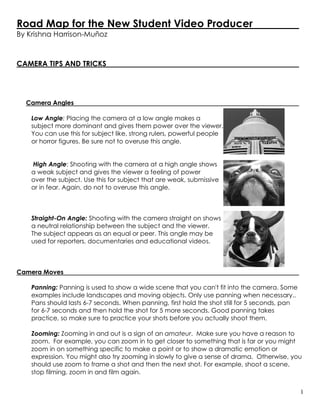
New Student Video Producer
- 1. Road Map for the New Student Video Producer By Krishna Harrison-Muñoz CAMERA TIPS AND TRICKS Camera Angles Low Angle: Placing the camera at a low angle makes a subject more dominant and gives them power over the viewer. You can use this for subject like, strong rulers, powerful people or horror figures. Be sure not to overuse this angle. High Angle: Shooting with the camera at a high angle shows a weak subject and gives the viewer a feeling of power over the subject. Use this for subject that are weak, submissive or in fear. Again, do not to overuse this angle. Straight-On Angle: Shooting with the camera straight on shows a neutral relationship between the subject and the viewer. The subject appears as an equal or peer. This angle may be used for reporters, documentaries and educational videos. Camera Moves Panning: Panning is used to show a wide scene that you can't fit into the camera. Some examples include landscapes and moving objects. Only use panning when necessary.. Pans should lasts 6-7 seconds. When panning, first hold the shot still for 5 seconds, pan for 6-7 seconds and then hold the shot for 5 more seconds. Good panning takes practice, so make sure to practice your shots before you actually shoot them. Zooming: Zooming in and out is a sign of an amateur. Make sure you have a reason to zoom. For example, you can zoom in to get closer to something that is far or you might zoom in on something specific to make a point or to show a dramatic emotion or expression. You might also try zooming in slowly to give a sense of drama. Otherwise, you should use zoom to frame a shot and then the next shot. For example, shoot a scene, stop filming, zoom in and film again. 1
- 2. Camera Shots 1. ls: long shot: Gets most of 2. ms: medium shot: Gets 3. mcu: medium close- up: a person or place in a scene. upper part of subject. Gets head and shoulders. 4. cu: close-up shot 5. ecu: extreme close-up 6. bust shot: Similar to ms, gets upper part, chest up. 7. knee shot: Shows the 8. two shot: Shows two 9. three shot: shows three subject from the knees up. subjects in the frame. subjects in the frame. 10. O/S: over-the-shoulder shot: 11. X/S: cross-shot: A shot sequence Camera looks at a person or object where the camera looks at one and over the shoulder of another person then the other person. The person near or object near the camera. the camera is out of the shot. 2
- 3. Camera Tips & Terms background: Always notice what is behind the subject or object. Don't let the background distract the viewer from watching the subject or object. cut-away shots: A shot that introduces something else that is not part of the action of the shot. For example, in a video about a the capital building in Sacramento, you may videotape the building, the rooms and the park and include these in the final project. headroom: Headroom is the space above a subject’s head. Typically, the top of the subject’s head should be near the top of the frame. Improper Proper headroom headroom Noseroom: Noseroom is the space in front of the subject’s face when your subject is looking to one side. Leave enough room in front of the nose so that it nose does not look squashed. Improper Proper noseroom noseroom ON THE MOVE What did you learn on these pages? Take notes. Now put it to practice! Notes: 3
- 4. Tips for On Camera Talent Everyone wants to look good on camera. It is typical for the person in front of the camera to ask, “Make me look skinny.” Even if you are not able to actually make the person skinnier, you can make he or she look good by following these basic rules. a. Clothing a. Wear pastel or solid colors. They are less distracting to the viewer. b. Avoid busy patterns. c. Keep jewelry simple. b. Makeup a. Be generous with lip and cheek color. More color gives life to the talent on camera. b. Use powder to diminish “shiny spots”. c. Posture a. Sit or stand in a relaxed and natural posture. b. Move slowly and steadily while being filmed. d. Speaking a. Speak slowly and clearly. b. Be yourself. Imagine you are talking to friends in your living room. ON THE MOVE: Back to Our Talent Watch the video and see if you can see how the subject didn’t follow the rules. Have fun! Notes: 4
